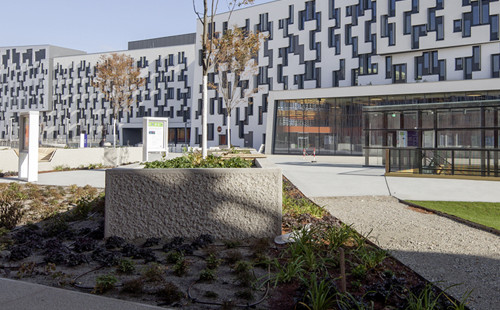Geschichte des Instituts für Wirtschaftsgeographie und Geoinformatik
1898-1998: The first hundred years
October 1, 1898: The Imperial Export Academy (k.k. Exportakademie) is established in the former Palais Festetics. Subjects taught include commodity science [Warenkunde], economics [politische Ökonomie], geography of trade [Handelsgeographie], public and private law, as well as several foreign languages [English and French]. There are three chairs [Politische Ökonomie, kaufmännisches Rechnen und internationale Handelskunde] and eight extraordinary positions [Geography of Commerce [Dr. Robert Sieger]]; Warenkunde, Zivil-, Handels- und Gewerberecht; Verwaltungs- und Verfassungslehre sowie Statistik; Handel- oder Wechselrecht; Stenographie; englische Sprache und Korrespondenz, französische Sprache und Korrespondenz].
Josef Schumpeter, student at the Imperial Export Academy from 1903 to 1905, passes the seminar course in Geography of Commerce in the study year 1903/1904 (see the picture of the certificate).
1905: In line with the importance of the discipline, a second extraordinary position [Wirtschaftsgeographie/Economic Geography] is established [upgraded to a chair position in 1909; first holder of the chair: Franz Heiderich, who became Rector 1923-1925].
1909: Foundation of Six Academic Institutes at the Imperial Export Academy including the Geographical Institute [Lehrkanzel für Handelsgeographie] and the Seminar for Economic Geography [Lehrkanzel für Wirtschaftsgeographie].
1918: Immediately following World War I, the Academy becomes a public World Trade University (Hochschule für Welthandel), offering a three-year degree program. Graduates are awarded the title of 'Diplomkaufmann'. Three so-called Commerce seminar courses are offered: Internationale Handelskunde; Handelsgeographie [Geography of Trade/Economic Geography]; Warenkunde [Commodity Science]; and two Law Seminar Courses, entitled Civil-, Handels- und Gewerberecht, and Wechsel- und Checkrecht. Students have to pass two final examinations: One in trade/economic geography, commodity science or English/French; the other in economics, business administration or business law.
1930: The University acquires the right to award doctoral degrees.
1959: The Seminar for Economic Geography is renamed to Institute for Economic Geography.
1966: University reforms lead to the introduction of degrees in social and economic sciences at several Austrian Universities. The World Trade University expands its range of degree programs to four study programs: Business Administration [Betriebswirtschaftslehre], Commerce [Handelswissenschaft], Business Education [Wirtschaftspädagogik], and Economics [Volkswirtschaftslehre]. Economic geography remains a compulsory part of the degree program in Commerce. Teaching staff: Twenty chair positions, including one for geography and one for economic geography.
1975: The University is again renamed, this time to Vienna University of Economics and Business Administration [Wirtschaftsuniversität Wien, short name WU].
1980: The Institute for Economic Geography [o. Univ. Prof. Dr. Erhart Winkler (1971-1985), succeeding Dr. Walter Strzygowski (1956-1970) in office] and the Geographical Institute [o. Univ. Prof. Dr. Karl Sinnhuber (1974-1987), successor of Dr. Leopold Scheidl (1954-1974, Rector 1963/64)] are forced to join and form the Institute of Economic and Social Geography.
1983: New regulations governing degrees in social and economic sciences are introduced. Economic geography loses its compulsory status in the study programs and the right to refill the chair position for geography. Foreign language teaching is expanded, and basic IT studies are made a compulsory part of the programs.
1988: Dr.habil. Manfred M. Fischer is appointed to refill the chair for economic geography [founded in 1905].
1989: The new chair establishes the Department of Theoretical and Applied Economic Geography to strive for international excellence in teaching and research. The Department starts with its Business GI study program, the first of its kind in Continental Europe, in line with the priorities set by the Rector in bringing IT knowledge strongly into the education agenda.
1997: The implementation of the 1993 University Organisation Act brings major changes to the WU's structure.
1998 and beyond: The next hundred years
1998: Organisation of the 38th Congress of the European Regional Science Association with the designated theme: Europe Quo Vadis? Regional Questions at the Turn of the Century, the first ERSA Congress for a quarter of a century to take place in Austria [five hundred plus registrants from six continents and 37 countries] and the Department's contribution to WU's centennial.
1999: The Institute for Economic and Social Geography [Chair: o.Univ.Prof.Dr.Manfred M. Fischer], the Institute for Regional Planning [Chair: o.Univ.Prof.Dr.Edward Bergman] and the Institute for Environment and Economy [Chair: Univ.Prof.Dr.Uwe Schubert] join to constitute the Institute for Economic Geography, Regional Development and Environmental Management. The Institute moves into its new premises in A-1090 Vienna, Rossauer Laende 23.
2002-2003: The WU introduces new study programs in Business Administration [Betriebswirtschaftslehre], International Business, Economic Sciences [Wirtschaftswissenschaften], Economics [Volkswirtschaftslehre] and Economic Informatics [Wirtschaftsinformatik]. The Institute and the Department enter into a new phase of their history.
2004-2005: The institute moves to a new location in the Nordbergstr. 15 in A-1090 Vienna. After reorganisation the institute splits into two new and independent institutes, the Institute for Economic Geography and GIScience (Chair: Professor Dr. Manfred M. Fischer), and the Institute for the Environment and Regional Development (current Chair: Prof. Dr. Gunther Maier), both belonging to the Department of Socioeconomics.
